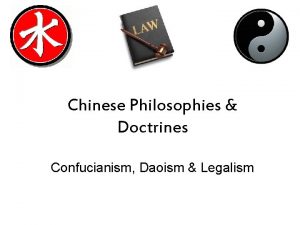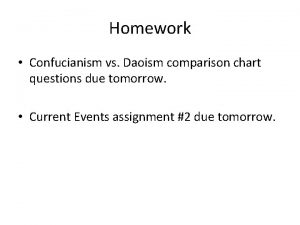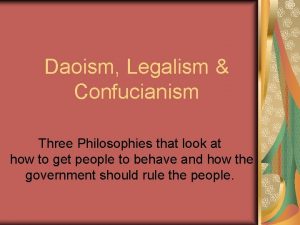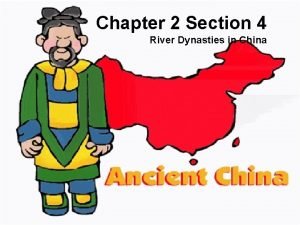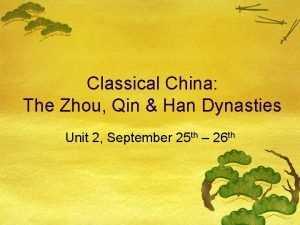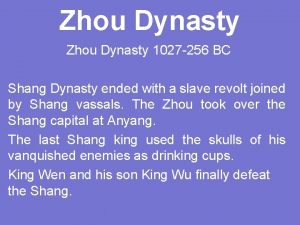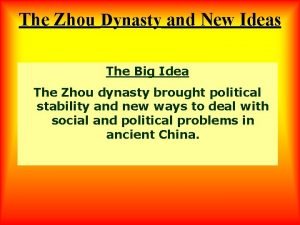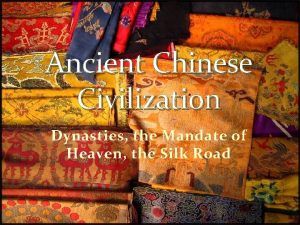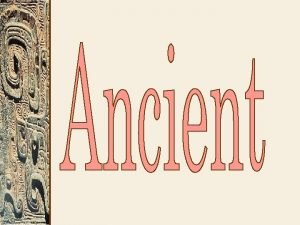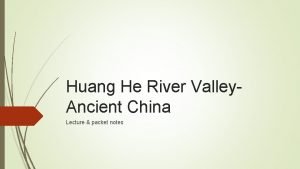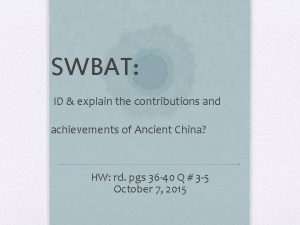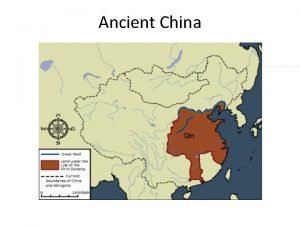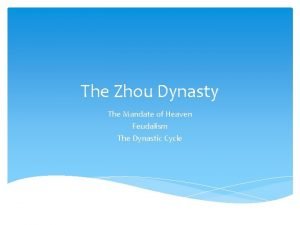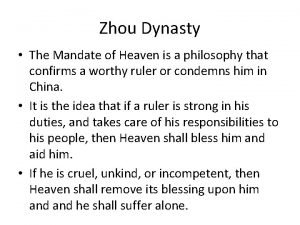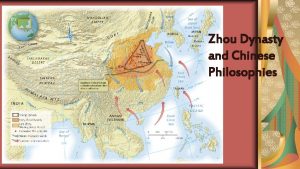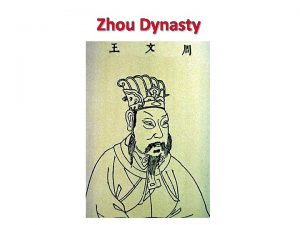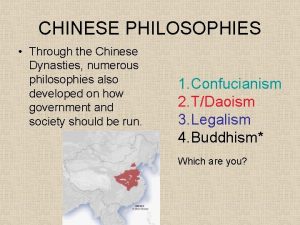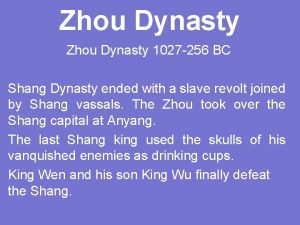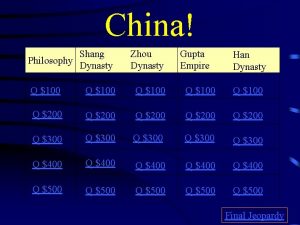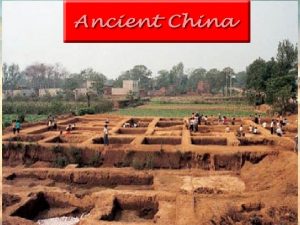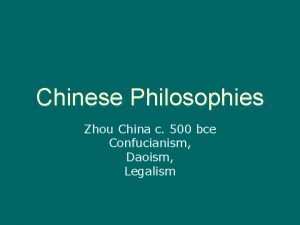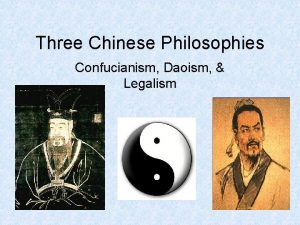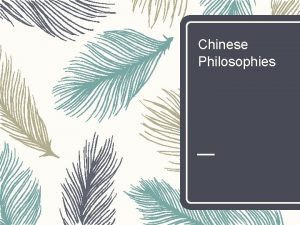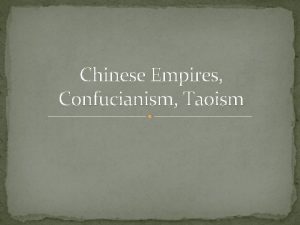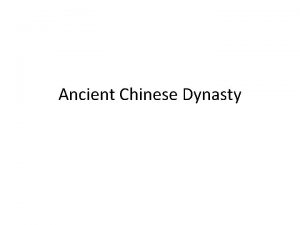Chinese Philosophies Zhou Chou dynasty ruled from 1028

















- Slides: 17

Chinese Philosophies • Zhou (Chou) dynasty ruled from 1028 -256 BC – ruled over a feudal system – the last 400 years of rule were filled with conflict – known as the time of Warring States, and also as the time of a Hundred Schools of Thought • Led to the development of many Chinese philosophies

Confucianism Confucius Temple, Suzhou

• Confucianism is NOT a religion but a philosophy (A School of Thought) • Founder Confucius (Kung Fu-tzu) – Students collected his sayings in the Analects

• Confucianism’s Key Duty- Filial Piety (respect for parents and elders) • Taught about Ethics (good and bad conduct), social order, importance of family, the value of education to the welfare of the individual and to society Confucius teaching his students.

• Emphasized social conformity • Harmony resulted when people accepted their place in society

• Five Key Relationships of Confucianism (Superior to Inferior) “An old man who lives together with 1. Ruler and subject his sons, grandsons and greatgrandsons is considered happy. The concept of "four generations living 2. Father and son under one roof" was admired and encouraged in the past. “ 3. Husband wife 4. Older brother and younger brother -Zhang Qian 5. Friend and friend – Superiors owe basic necessities and a good example to inferiors. – Inferiors owe respect and obedience to superiors

Daoism The tiger and dragon are ancient symbols of yin and yang, forces that combine to make up the universe. Ancient Chinese Taoist philosophy explains the world in terms of two forces—yin (from the ancient Chinese word for “shady”) and yang (from the word for “bright”). Yang elements include light, fire, rain, and the heavens. Yin elements include darkness, water, wind, and the earth. Male traits are yang, and female traits are yin. Yang qualities are active, while yin qualities are passive. Everything in the universe results from the interaction of yin and yang

• Founder of Daoism was Laozi (Lao tzu) “ The Old Master” • Sacred text is called The Way of Virtue

• Laozi believed that you should ponder the Dao/Tao (source of life / the way) to find harmony with Nature and the Universe. • Nature is a marriage of opposites: yin-yang, female and male

• Daoism emphasized – Natural order is more important than social order – Personal freedom – Self-knowledge and contemplation – The relationship between people and nature Taoist Shrine

• Taoism maintains that the best government is the one that had the fewest rules and laws and left the people alone The Emperor Wen doing what an emperor should do.

• Many people in China were Confucian when dealing with family and society and Daoist when involved in individual meditation with nature. Taoist Temple at Qing Cheng Shan

Legalism • Tomb of Emperor Qinshihuang

• Legalists believed that government should be highly efficient and powerful. • The government should use law to enforce order Hanfiezi, founder of legalism

• Very harsh punishments were instituted to achieve an orderly society Working on the Great Wall was exhausting and difficult. It was often used as a punishment for people who spoke out against ideas or did not obey the Legalist government’s laws. Hundreds of thousands of people worked on the wall-about 6 times the amount of people that would fit into a baseball stadium. Many of them died fulfilling Qin’s goal of protecting China. The wall was an impressive accomplishment, but in the end, it did little to stop invaders from finding their way into China. - Angela Stevenson

• Legalists urged the emperor to control the people’s thoughts as well as their actions. • Emperor known as Qinshihuang followed legalists’ suggestionsincluding executing thousands of Confucian scholars.

August 2010 Regents Exam • Historical Context: • Throughout history, the spread of belief systems has influenced social, economic, and political developments in many regions. These belief systems include Islam, Christianity, and Buddhism. • Task: Using the information from the documents and your knowledge of global history, answer the questions that follow each document in Part A. Your answers to the questions will help you write the Part B essay in which you will be asked to • Select two belief systems mentioned in the historical context and for each – Describe how the belief system spread to a specific region or regions – Discuss how the belief system influenced a region or regions socially, economically, and/or politically
 Weather station model
Weather station model Chinese philosophies comparison chart
Chinese philosophies comparison chart Chinese philosophies comparison chart
Chinese philosophies comparison chart Legalism teachings
Legalism teachings Chapter 2 section 4: river dynasties in china answer key
Chapter 2 section 4: river dynasties in china answer key Zhou
Zhou Zhou dynasty facts
Zhou dynasty facts The zhou dynasty and new ideas
The zhou dynasty and new ideas Zhou dynasty achievements
Zhou dynasty achievements China zhou dynasty
China zhou dynasty Huang ho river valley civilization
Huang ho river valley civilization Achievements of xia dynasty
Achievements of xia dynasty Ancient china han
Ancient china han Ancient china zhou dynasty
Ancient china zhou dynasty Zhou dynasty map
Zhou dynasty map Zhou dynasty facts
Zhou dynasty facts Feudalism zhou dynasty
Feudalism zhou dynasty Mandate of heaven and warring states
Mandate of heaven and warring states

